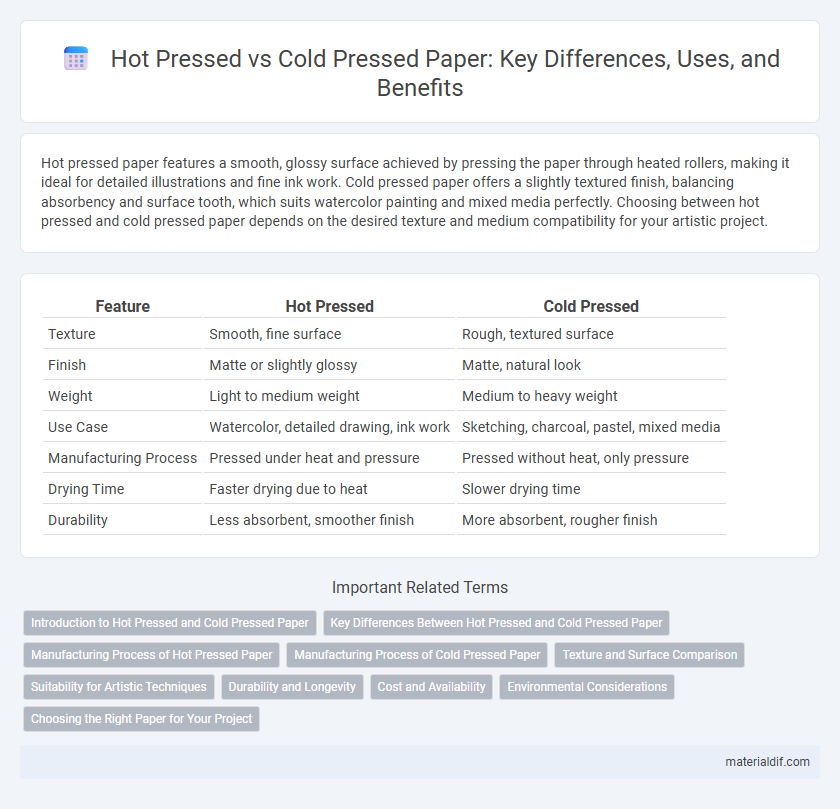Hot pressed paper features a smooth, glossy surface achieved by pressing the paper through heated rollers, making it ideal for detailed illustrations and fine ink work. Cold pressed paper offers a slightly textured finish, balancing absorbency and surface tooth, which suits watercolor painting and mixed media perfectly. Choosing between hot pressed and cold pressed paper depends on the desired texture and medium compatibility for your artistic project.
Table of Comparison
| Feature | Hot Pressed | Cold Pressed |
|---|---|---|
| Texture | Smooth, fine surface | Rough, textured surface |
| Finish | Matte or slightly glossy | Matte, natural look |
| Weight | Light to medium weight | Medium to heavy weight |
| Use Case | Watercolor, detailed drawing, ink work | Sketching, charcoal, pastel, mixed media |
| Manufacturing Process | Pressed under heat and pressure | Pressed without heat, only pressure |
| Drying Time | Faster drying due to heat | Slower drying time |
| Durability | Less absorbent, smoother finish | More absorbent, rougher finish |
Introduction to Hot Pressed and Cold Pressed Paper
Hot pressed paper features a smooth, polished surface created by pressing paper fibers under heat, ideal for detailed artwork and ink applications. Cold pressed paper undergoes a gentler pressing process, resulting in a slightly textured surface that balances absorbency and smoothness, making it popular for watercolor painting. The choice between hot pressed and cold pressed paper depends on the desired texture, absorbency, and the type of medium used.
Key Differences Between Hot Pressed and Cold Pressed Paper
Hot pressed paper features a smooth, polished surface achieved through heat and pressure during manufacturing, making it ideal for detailed ink illustrations and fine pen work. Cold pressed paper has a slightly textured finish created without heat, offering better absorption and a preferred surface for watercolor techniques that require varied brushstrokes and blending. The key differences lie in their surface texture, absorbency, and suitability for different artistic mediums, with hot pressed paper delivering precision and cold pressed enhancing color diffusion.
Manufacturing Process of Hot Pressed Paper
Hot pressed paper is manufactured by compressing pulp fibers under high temperature and pressure, resulting in a smooth, hard surface ideal for detailed artwork and fine printing. The heat and pressure in the hot pressing process create a denser fiber structure, enhancing durability and reducing surface absorbency. This manufacturing technique produces paper with a consistent texture and minimal surface grain, making it preferred for precise ink and paint applications.
Manufacturing Process of Cold Pressed Paper
Cold pressed paper is manufactured by gently pressing pulp at low temperatures, preserving the natural fibers' texture and strength. This process involves minimal heat and pressure, resulting in a smooth surface with slight texture ideal for detailed artwork and watercolor techniques. The controlled pressing prevents fiber damage, enhancing durability and allowing better paint absorption compared to hot pressed variants.
Texture and Surface Comparison
Hot pressed paper features a smooth, polished surface with minimal texture, ideal for detailed work and fine ink application, while cold pressed paper presents a slightly textured, toothier surface that enhances watercolor absorption and layering techniques. The dense, flat surface of hot pressed paper allows for sharp, precise lines and vibrant color transparency, contrasting with cold pressed paper's more absorbent quality that encourages softer edges and blended washes. Artists choose hot pressed paper for crisp detail and cold pressed for dynamic texture and depth in their artwork.
Suitability for Artistic Techniques
Hot pressed paper features a smooth, even surface ideal for detailed ink drawings, fine line work, and watercolor techniques requiring sharp edges. Cold pressed paper offers a textured surface that enhances the absorption of paint, making it suitable for expressive brushes, washes, and mixed media. Artists select paper based on the interaction between surface texture and medium to achieve desired effects in their artwork.
Durability and Longevity
Hot pressed paper features a smooth, dense surface achieved through heat and pressure, enhancing its durability and resistance to wear over time. Cold pressed paper, while slightly textured and more absorbent, typically exhibits less structural resilience, making it more prone to aging and surface damage. For projects requiring long-lasting quality and sturdiness, hot pressed paper provides superior longevity compared to cold pressed options.
Cost and Availability
Hot pressed paper generally costs less due to its faster production process and higher availability in bulk for commercial printing needs. Cold pressed paper, being more textured and requiring a slower drying process, tends to be pricier and less readily available, often preferred by artists for watercolor work. Bulk retailers and online suppliers commonly stock hot pressed varieties, while cold pressed paper may require purchase through specialized art supply stores.
Environmental Considerations
Cold pressed paper production typically consumes less energy and generates fewer emissions compared to hot pressed methods, making it more environmentally friendly. Hot pressed paper often involves higher temperatures and increased chemical usage, contributing to a larger carbon footprint and potential toxic waste. Choosing cold pressed paper supports sustainable forestry practices and reduces the overall environmental impact of paper manufacturing.
Choosing the Right Paper for Your Project
Hot pressed paper offers a smooth surface ideal for detailed illustrations and fine line work, making it perfect for projects requiring precision. Cold pressed paper has a slightly textured surface, providing better absorption and a natural feel favored in watercolor paintings and mixed media. Selecting the right paper depends on the desired finish, medium compatibility, and the level of detail required in your artwork or print project.
Hot Pressed vs Cold Pressed Infographic

 materialdif.com
materialdif.com